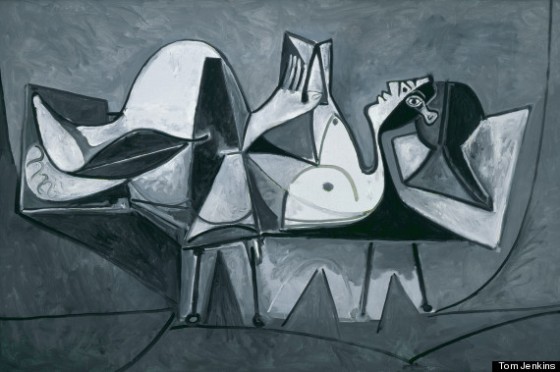…I pondered out loud to my mother, in Picasso Black and White at the Guggenheim.
Well, have you? Yes, there may be ones you don’t personally care for, and perhaps some that are not as GREAT as others, but have you ever seen one that was truly BAD? I’ve seen many bad Matisses, bad Pollocks, but bad Picassos? I don’t think so.
To be fair, I said this towards the top of the ramp as we worked our way down, thus going backwards through the exhibition chronologically and so starting with his late work, when his experienced hand, no matter how lazy it got (works were mostly completed in one day, though I’m not necessarily claiming that as a barometer of laziness), could do no wrong. Every stroke was a masterpiece, not one element of a picture out of place. My mother quoted a label from the Museum of Bad Art that jokingly cites a mediocre painter’s “triumph of self-confidence.” Each late Picasso is such a triumph, except in his case it’s justifiable, rather than deluded.
And, to slightly amend my earlier bold assertion, as we progressed (regressed?) to earlier work, one could definitely see the more uncertain efforts of the younger Picasso – more trial and error, compositions with barely or badly masked earlier outlines.
This was the rare show in which my primary mental activity was contemplating the compositional merits and demerits (though not much of the latter) of each work, rather than the concepts underlying each work or the exhibition as a whole. I’m not sure that the curators really demonstrated their argument–“Claiming that color weakens, Pablo Picasso purged it from his work in order to highlight the formal structure and autonomy of form inherent in his art” (if so, why did he also do so many works with so much color?)–but who really cares? It’s a bunch of Picassos at the Guggenheim – is anyone going to deny the broad appeal of such a show (as evidenced by the surging crowds, bolstered by the holidays and bad weather)?
And so, with an exhibition premise that didn’t mean much except as an excuse to show a bunch of Picassos, we were free to just look at the art, except when we were distracted by the odd gamut of frames–from Spanish colonial to Dutch baroque to American folk to modernist blond wood–nearly all of which distracted and detracted from the work in some way.
It was fun to debate Picasso’s intentions, particularly in regard to those old marks that he made little effort to hide: did he not care? did he not consider the work finished? did he think these palimpsests added something to the composition? There was another perhaps unintended but now unavoidable compositional element on canvases that may have once been white and are now yellow, adding color where he may have wanted none (though many works did incorporate color highlights), and making white brushstrokes stand out where they were meant to blend in.
It’s always worthwhile to go see some Picassos you haven’t seen before. But maybe wait til after New Year’s, when the tourists retreat. Coming soon, a Chelsea misadventure…



Pingback: Regarding “Regarding Warhol” | SmARTy ART Chick
Pingback: What I Actually Saw in New York, part 2; plus bonus quickie reviews | SmARTy ART Chick
Shows like that are like a big meal. After a while your enthusiasm flags, and it becomes difficult to evaluate individual works– or even periods of work– in quite the same way. Coincidentally, over the summer we were at a Picasso retrospective in Toronto and I found myself becoming overwhelmed and exhausted as we proceeded towards the end. What revived me was working backwards through the show a second time. I felt like that gave me some perspective that I’d lost.